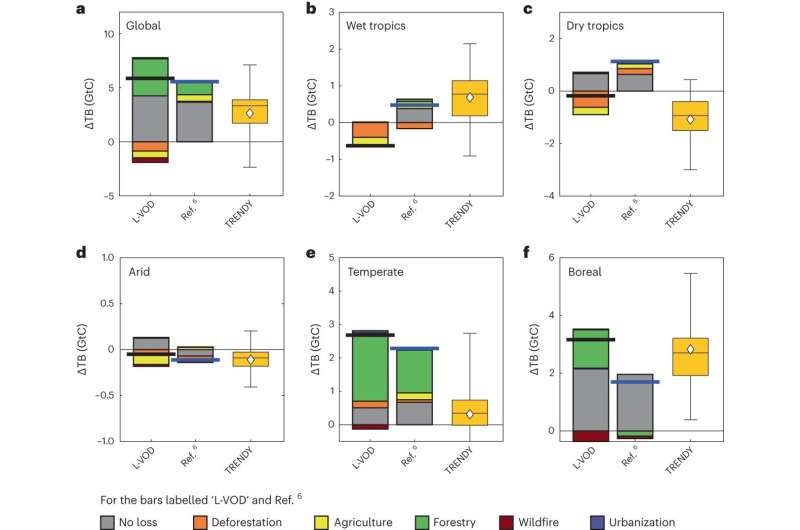This article has been reviewed according to Science X's editorial process and policies. Editors have highlighted the following attributes while ensuring the content's credibility:
fact-checked
peer-reviewed publication
proofread
Boreal and temperate forests now main global carbon sinks, satellite image analysis finds

Using a new analysis method for satellite images, an international research team, coordinated by the French Alternative Energies and Atomic Energy Commission (CEA) and INRAE, mapped for the first time annual changes in global forest biomass between 2010 and 2019.
Researchers discovered that boreal and temperate forests have become the main global carbon sinks. Tropical forests, which are older and degraded by deforestation, fire and drought, are nearly carbon neutral. The findings, published in Nature Geoscience, highlight the importance of accounting for young forests and forest degradation in predictive carbon‑sink models to develop more effective climate change mitigation strategies.
Increases in plant biomass play an essential role in carbon sequestration to mitigate climate change. The carbon balance of biomass results from gains due to plant growth and increased forest cover and losses due to harvest, deforestation, degradation, background tree mortality and natural disturbances.
Monitoring biomass carbon stocks over time is essential to better understand and predict the effects of ongoing and future climate change, as well as the direct impacts of human activities on ecosystems. This is a key issue for climate change mitigation policies.
The vegetation data, obtained from the Soil Moisture and Ocean Salinity (SMOS) satellite using L-band vegetation optical depth (L-VOD) methods, is unique in estimating average above-ground carbon stocks on a global level. However, the widespread application of L-VOD over the entire globe is limited by signal disruption from radio frequency interference from human activities and by L‑VOD sensitivity to vegetative water content.
To address these challenges, the researchers developed a double filter that used temporal signal decomposition (seasonal changes, trends, etc.) to offset these effects. Drawing on above-ground biomass data, researchers determined total biomass using a global map, released in 2020, of the ratio between above- and below-ground biomass (such as roots).
They then calculated the spatial and temporal distribution of total live biomass carbon of terrestrial ecosystems from 2010 to 2019, and developed maps of annual biomass carbon change. Researchers used the maps to assess regional carbon budgets (25×25 km plots), attribute carbon losses and gains to forest-cover change caused by fires and land-use change, and investigate how forest age controls terrestrial carbon storage.
Carbon stocks on Earth increased by 500 million metric tons per year over a 10-year period
Globally, terrestrial biomass carbon stocks increased from 2010 to 2019 by approximately 500 million metric tons of carbon per year. The main contributors to the global carbon sink are boreal and temperate forests, while tropical forests have become small carbon sources because of deforestation and tree mortality following periods of repeated drought.
Old-growth tropical forests, where trees average more than 140 years old, are nearly carbon neutral, whereas temperate and boreal forests, where trees are young (less than 50 years) or middle-aged (50–140 years), are the largest carbon sinks. The new findings differ from existing prediction models that show all old-growth forests to be large carbon sinks and do not account for the importance of forest demography or the impact of deforestation and degradation on tropical forests, which are losing biomass.
The findings highlight the importance of accounting for forest degradation and forest age when predicting dynamics of future carbon sinks at global level, and thereby develop better-suited climate change mitigation policies.
More information: Yang, H. et al, Global increase in biomass carbon stock dominated by growth of northern young forests over past decade. Nature Geoscience (2023). DOI: 10.1038/s41561-023-01274-4. www.nature.com/articles/s41561-023-01274-4
Journal information: Nature Geoscience
Provided by INRAE - National Research Institute for Agriculture, Food and Environment




















